Imagine stepping into a lush, tropical oasis, surrounded by the captivating foliage of a monstera plant. Its large, split leaves seem to reach out, beckoning you to take a closer look. This alluring houseplant has captured the hearts of plant enthusiasts worldwide, and for a good reason. Learning how to propagate a monstera in water can be a rewarding and satisfying experience. It lets you multiply these stunning plants and share them with friends or grow your own thriving collection.
The monstera plant, also known as the Swiss cheese plant or split-leaf philodendron, is famous for its vibrant, eye-catching foliage. With its striking perforated leaves and climbing, trailing habit, it’s no wonder this tropical beauty has become a staple in homes and offices across the globe. Propagating monstera plants in water is a simple and effective method. It allows you to create new, healthy plants from existing ones.
Key Takeaways
- Monstera plants can be easily propagated in water, allowing you to multiply your collection.
- The ideal temperature for propagating monstera is between 70-85 degrees Fahrenheit, with a humidity level of 50-60%.
- Regularly changing the water (every 2-3 days) is crucial to prevent bacterial growth and support healthy root development.
- Transplanting the rooted cutting (with 2-3 inch roots) into a well-draining potting mix is the final step in the water propagation process.
- Monitoring the cutting’s growth and providing the right care, such as lighting and watering, is essential for the plant’s success after propagation.
Introduction to Monstera Propagation
The Monstera plant, also known as the Swiss cheese plant, is truly captivating. It comes in various stunning varieties. From the large, perforated leaves of Monstera deliciosa to the delicate Monstera adansonii, each type has its own charm. Propagating these Monstera varieties is rewarding for plant lovers.
Different Varieties of Monstera
- Monstera deliciosa: The iconic large-leaf Monstera with its distinctive holes and splits.
- Monstera adansonii: A smaller-leaf variety with a more compact growth habit.
- Monstera variegata: A stunning variegated form, showcasing a captivating mix of green and white leaves.
- Monstera obliqua: A rare and highly perforated variety with a lacy, delicate appearance.
Why Propagate Monstera?
Propagating Monstera plants has many benefits. It lets you make new plants, share with friends, and refresh the mother plant. This method keeps your Monstera collection thriving and full of life.
“Propagating Monstera plants is a wonderful way to share the joy of these stunning foliage plants with others.”
https://www.youtube.com/watch?v=SZ8fwPB4Kq0
Preparing for Water Propagation
To successfully propagate a monstera plant in water, you’ll need some key tools and materials. First, get a sharp, sterilized pruning tool like shears or a knife for clean cuts. Also, have a clear container ready, like a glass jar or a vase, for the cuttings and water.
Tools and Materials Needed
- Sterilized pruning shears or sharp knife
- Clear container (glass jar, vase, etc.)
- Filtered or distilled water
Selecting a Healthy Stem Cutting
When picking monstera cuttings, choose a healthy stem with at least one node and any aerial roots. The node is key for new roots to grow. Cut the stem 4-6 inches long, just below the node, for the best chance of success.
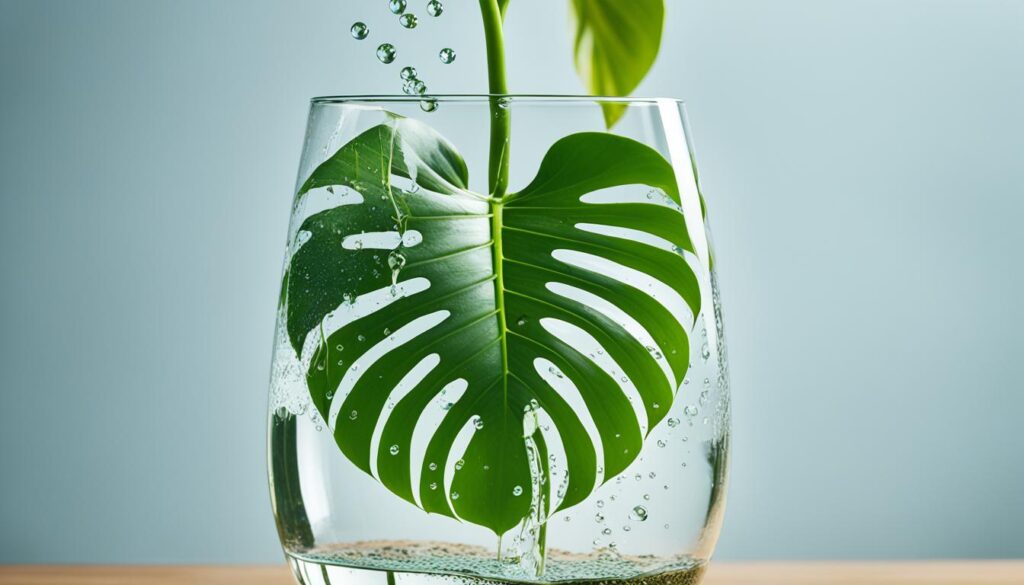
“Look for a healthy stem with at least one node and any aerial roots present. The node is where the new roots will emerge, so it’s an essential part of the cutting.”
The quality of the cutting is vital for success. Pick a part of the plant that’s free from damage or disease. This gives your new monstera plant the best start.
Step-by-Step Guide to Water Propagation
Propagating a monstera in water is easy and can lead to great results. Begin by picking a healthy stem cutting with a mature leaf and an aerial root. Then, remove the lower leaves to show the node where roots will grow.
- Fill a clear container, like a jar or glass, with filtered water. Make sure the node and aerial roots are fully covered.
- Put the container in a spot with bright, indirect sunlight. Avoid direct sunlight to prevent the water from getting too hot and harming the cutting.
- Change the water every 3-4 days to stop bacteria and fungi from growing. This keeps the water clean and helps the cutting stay healthy.
Watch the cutting for new roots, which should appear in 2-3 weeks. Roots will grow from the node, showing that the step-by-step monstera water propagation is working.
Be patient as the how to propagate monstera in water process takes time. Keep the cutting moist and adjust the water level to keep the node and roots underwater.
“Propagating Monstera plants can be a cost-effective way as they are known to be somewhat expensive to purchase.”
With proper care and patience, your monstera cutting will grow strong roots. This prepares it for a successful move to soil.
How to propagate a monstera in water?
Propagating a monstera plant in water is easy and rewarding. Make sure the node and aerial roots on the stem cutting are submerged in the water. This helps the roots grow and gives the new plant a strong base.
Submerging the Cutting
When getting ready for water propagation, pick a healthy stem with at least one node and aerial root. Cut the stem at a 45-degree angle, just below the node. Then, put the cutting in a clean, sterilized container with fresh, dechlorinated water.
Maintaining Water Quality
To keep the water clean, change it every 3-4 days. This stops bacteria and fungi from growing. It also makes sure the cutting gets the nutrients and oxygen it needs for healthy roots.
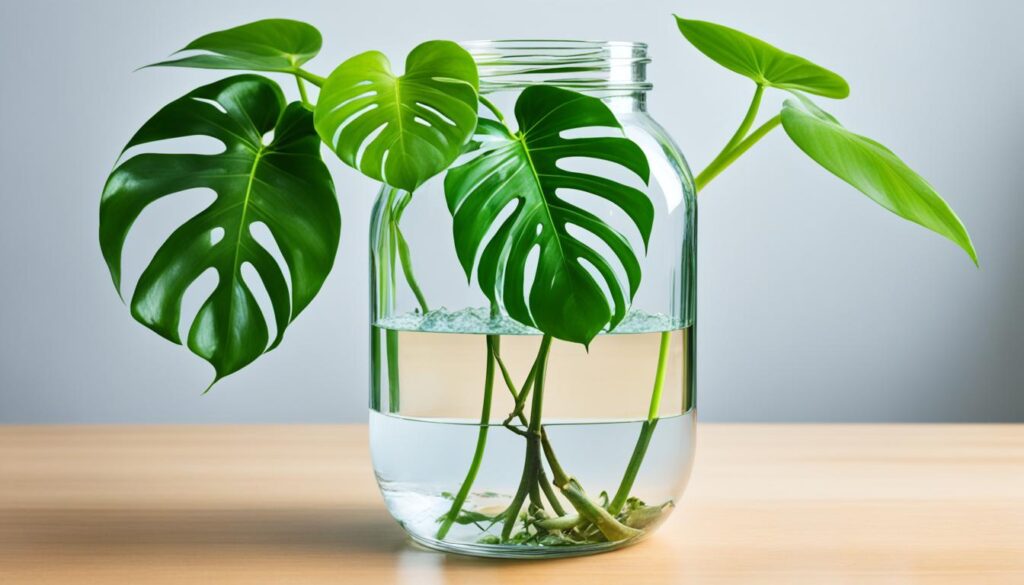
“Proper water maintenance is crucial for successful monstera propagation in water. Changing the water regularly helps keep the cutting healthy and promotes strong root growth.”
By following these easy steps, you can propagate your monstera. Soon, you’ll have a beautiful, easy-to-care-for plant at home. With a bit of care, you’ll enjoy a thriving monstera for many years.
Monitoring Root Development
Starting your monstera water propagation journey means keeping an eye on the roots. This is key for a smooth move from water to soil. You should see roots growing well in 2 to 3 weeks after planting your cutting in water.
Watch for the roots to get 3 to 4 inches long. This means the cutting is set to move to soil. Check the roots’ color and feel. Healthy roots are white or light and feel firm and strong.
To keep roots growing well, change the water every 3 to 4 days. This stops bacteria from growing and keeps oxygen levels right for the roots.
Patience and careful watching are the secrets to successful monstera propagation. By watching the roots closely, you make sure your cutting is soil-ready. This sets it up for growth and health.
“Monitoring the root growth during monstera water propagation is the secret to a healthy, vibrant plant.”
Transitioning to Soil
Once your monstera cutting has grown roots in water, it’s time to move it to soil. Picking the right potting soil for monstera is key for repotting monstera cuttings and their growth.
Choosing the Right Potting Mix
Choose a potting mix that drains well and is full of nutrients, made for aroid plants like monstera. Aim for a mix without peat moss and perlite for good aeration and drainage for the roots.
Repotting Rooted Cuttings
When transitioning monstera from water to soil, gently move the rooted cutting into a new pot. Be gentle with the roots to avoid damage. Water the soil well after moving to help the monstera settle.
Success in transitioning monstera from water to soil comes from the right potting mix and careful handling of roots. With the correct potting soil for monstera and repotting steps, your monstera cutting will do well in its new soil home.

“Transitioning a monstera cutting from water to soil can be a delicate process, but with the right preparation and care, your plant will thrive in its new environment.”
Propagation by Soil Method
While water propagation is popular for Monstera plants, soil propagation is also effective. This method takes a stem cutting from a healthy Monstera plant and plants it in a well-draining potting mix.
To start, pick a sturdy, disease-free stem and cut it just below a leaf node. Then, dip the cut end in rooting hormone powder or gel to help roots grow. Plant the cutting in a pot with a good potting mix for tropical plants.
- Water the soil lightly, making sure it’s moist but not too wet.
- Put a transparent plastic bag or dome over the pot to keep humidity high, which helps roots grow.
- Put the pot in a warm, bright spot, but not in direct sunlight. Check the soil moisture often.
The soil propagation method for Monstera takes about 4-5 weeks for roots to grow. This is longer than water propagation. But, the roots that grow are stronger and better suited for soil.
Once the cutting has strong roots, you can slowly get it used to its new home. Start by removing the plastic cover and giving it more light.
“Propagating Monstera plants in soil is a rewarding experience, as it allows you to witness the entire growth process from cutting to a thriving new plant.”
Choosing to propagate Monstera in soil or water is up to you. But, the main thing is to give your plants the right conditions. This means consistent moisture, warmth, and humidity. With patience and care, you can grow more Monstera plants and share them with others.
Air Layering for Monstera Propagation
Monstera fans looking for a new way to propagate can try air layering. This method helps roots grow right on the plant, making it more successful than other ways. Wrap a stem part with damp sphagnum moss and cover it with plastic to make aerial roots. Then, you can pot these roots as a new Monstera plant.
Preparing for Air Layering
Start by picking a strong, grown stem on your Monstera. Cut a bit of the stem just below a leaf node with a clean knife. This helps the plant grow roots there instead.
Then, cover the cut with wet sphagnum moss. Make sure it’s fully covered. Use clear plastic wrap to keep it moist, securing it with ties or string.
Monitoring Root Growth
Watch the air layering for a few weeks. Look for new aerial roots in the moss. When roots are an inch long, it’s time to separate the new plant.
Remove the plastic and moss, then cut below the roots with a sharp knife. This will free the new plant.
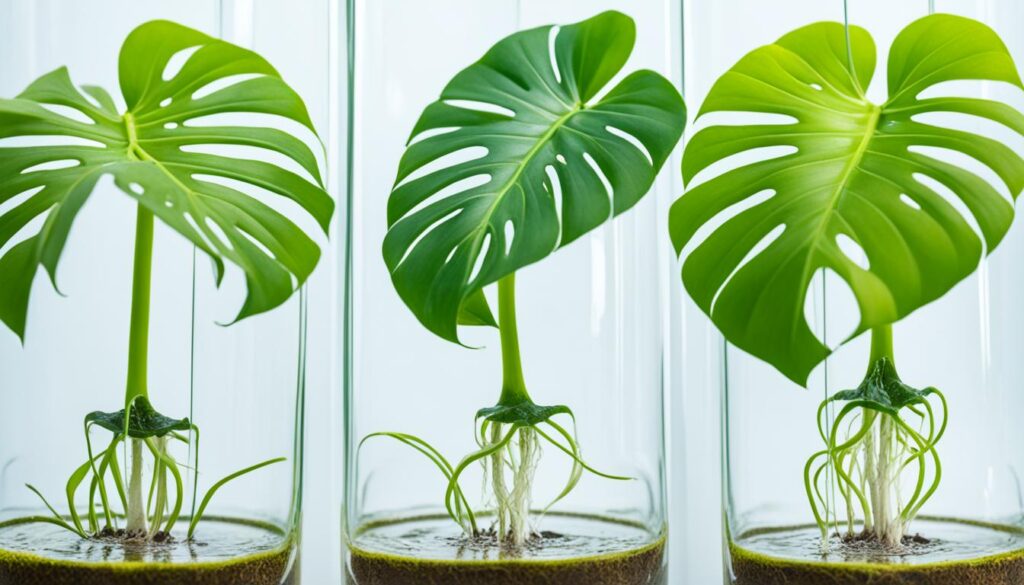
Plant the new Monstera in a mix of peat moss, perlite, and pine bark. Keep it in bright, indirect light and moist soil. After a month, start feeding it with a Monstera plant food to help it grow.
Care and Maintenance After Propagation
Congratulations on successfully propagating your new monstera plant! Now, let’s make sure it grows well and stays healthy. There are two main things to think about: light and watering and humidity.
Light Requirements
Monstera plants love bright, indirect light. Don’t put them in direct sunlight, as it can burn the leaves. Instead, find a spot in your home with lots of bright, indirect light, like near a window or under a skylight. This kind of light helps your monstera grow strong and healthy.
Watering and Humidity Needs
Getting the watering right is key for the care for propagated monstera. Let the soil dry out a bit before you water it again. Monstera likes soil that drains well and doesn’t get too wet. Also, keeping the air around it high in humidity helps it grow lush and green. You can mist the leaves often or use a pebble tray to keep the air moist.
By giving your monstera the right light, water, and humidity, it will keep doing well. And you’ll get to enjoy the beauty of your new plant.
“Caring for a propagated monstera plant is all about striking the right balance between light, water, and humidity. With the proper care, your new plant will thrive and bring a touch of tropical beauty to your home.”
Common Problems and Troubleshooting
Propagating monstera plants is usually easy, but gardeners might run into some issues. Problems like root rot, stem rot, and slow root growth can happen. It’s important to watch for these and fix them quickly for success.
Root rot is a big problem in monstera propagation. It happens when the cutting stays in still water too long. This creates a perfect spot for bad bacteria and fungi to grow. To stop this, change the water often and make sure it drains well when moving the cutting to soil.
Stem rot can also occur if the cutting gets damaged or sits in too much water. Pick a healthy stem and only put the lower part in water. Keep the top part dry.
- Slow root growth can be tough, but don’t give up. Not enough light, uneven water, or low humidity can cause this. Make sure your cutting gets bright, indirect light and stays moist.
- Yellow leaves on your monstera might mean you’re watering too much or too little, or it’s getting too much sun. Change how you water and light your plant.
- Brown spots on leaves could mean root rot. Fix this by improving the soil’s drainage and watering less often.
Keep an eye on your cutting for any signs of trouble or disease. Adjust things like light and water as needed. This way, you can fix common issues and grow a healthy new monstera plant.
“The key to successful monstera propagation is vigilance and a willingness to adapt to the plant’s needs.”
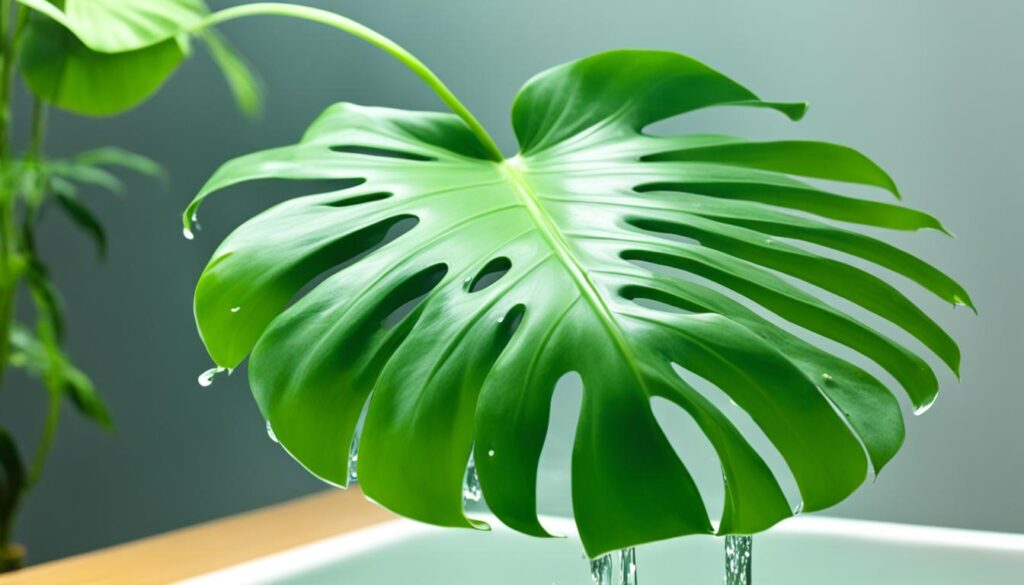
Benefits of Propagating Monstera
Propagating monstera plants has many benefits for those who love plants. You can make new plants that look just like the original. This lets you grow your collection or share plants with others, spreading the beauty of these plants.
There’s more to it than just making new plants. Propagating your monstera helps keep the original plant healthy and full. Cutting and replanting stems makes the plant fuller and stops it from looking thin or uneven.
- Expand your monstera collection at a fraction of the cost of buying new plants
- Share the beauty of monsteras with loved ones by gifting propagated cuttings
- Promote the healthy, lush growth of your mother plant through regular propagation
Propagating monstera plants is both fun and educational. Seeing new roots grow and watching the cutting become a strong plant is magical. It’s also a budget-friendly way to bring these unique plants into new spaces, adding tropical beauty anywhere they go.
“Propagating monstera plants is a rewarding and educational experience that allows you to expand your collection, share the love, and keep your mother plant healthy and happy.”
Whether you’re an experienced plant owner or just starting, propagating monstera plants is exciting. It brings joy from creating new life and satisfaction from a thriving plant collection. The benefits of this process are endless.
Conclusion
Propagating a Monstera plant in water is easy and fun. By following a simple guide, picking healthy cuttings, and giving them the right care, you can grow new Monstera plants. You can add them to your collection or share them with others.
With the right methods and patience, you’ll enjoy the key takeaways for propagating Monstera. These plants are beautiful and easy to take care of.
When propagating Monstera in water, it’s key to pick the best time and have the right tools and materials. Keep an eye on the roots and plant health as they grow. This way, you can avoid problems like too much water or low humidity.
If you love plants or are new to Monstera propagation, this guide has everything you need. It’s exciting to watch your cuttings grow and flourish. Share the beauty of these plants with your loved ones.
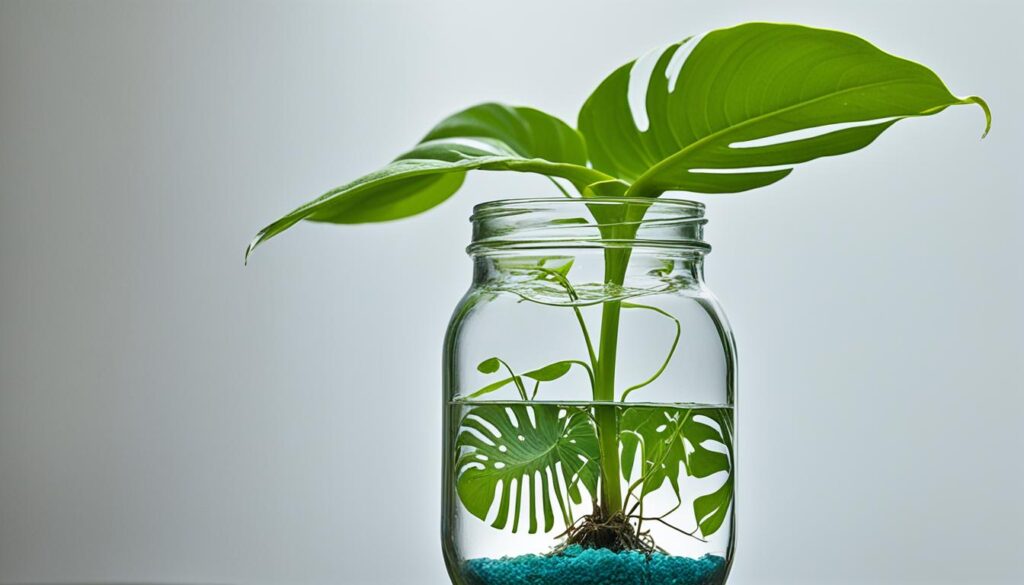


Thanks for sharing. I read many of your blog posts, cool, your blog is very good.